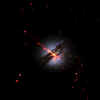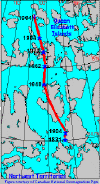 End
Of The World Events Detail
End
Of The World Events Detail End
Of The World Events Detail
End
Of The World Events DetailLast revised: 05/22/01 07:29 PM about 39 seconds to load @ 28.8kb
link to: End Of The World Events Summary Information
Unknown: Super SolarFlares would destroy ozone layer, electrical devices, & power grids.
Solar Flares are our solar system's largest explosive events, equivalent to approximately 40 billion Hiroshima-size atomic bombs. A Super Flare would melt ice on the moons of Saturn.
All satellites are destroyed and would also likely blow out electrical power grids around the world. Earthís upper atmosphere would prevent the flare radiation from reaching the ground, but would destroy the ozone layer.
A event in 1982 resulted in a temporary 70% decrease in ozone densities.
X-ray energy burst from nearby Black Hole system like V2641 Sagittarii. (about 1,500 light years away), but closer. See Local GRB. Newborn star sends gas jet toward earth. Milky Way becomes an Active Galaxy.
Black hole at center of Milky Way galaxy turns on and starts generating dangerous levels of radiation.
Such as Meteor Crater, Tunguska in Siberia in 1908, or The Dinosaur killer at Yuctan, Mexico..It is not known when the next NEO impact will take place, but the odds can be calculated. Statistically, the greatest danger is from an NEO with about 1 million megatons energy, a 'Impact Winter' sized asteroid (roughly 2 km in diameter). On average, one of these collides with the Earth once or twice per million years, producing a global catastrophe that would kill a substantial (but unknown) fraction of the Earthís human population.
I've seen different versions of the following chart and when I find an official chart, I will use it instead. The last Classification is one I created.
Classification |
Size |
Type |
Destruction Zone |
Last Known |
| Local Damage | 5 to 200 m | Tunguska | City to State | '1994 XL1' It missed Earth by 65,000 miles. |
| Widespread Devastation | 200 m to 1.6 km | Meteor Crater | State to Nation | 47,000 BC |
| Impact Winter | 1.6 km to 16 km | Yuctan | Nation to planet | 65 million BC |
| Doomsday | 16 km to small moon | Unknown | Planet wide to all life extinct | unknown |
| Planet
Destroyer
|
Small moon and up | Earth's Moon | Loss of atmosphere to planet broken up | 4.4 billion BC Moon Creator |

Measurements show that the locations of the magnetic poles are drifting today. Based on the current rate of decay of Earth's dipole field strength is that the next reversal could occur within the next 2000 years.
2,130 Years: Solar cycles of 88, 212, and 2130 years will cause average world wide. temperature changes of 3 digs F or more causing excessive hot/cold spells.
Glacial Period. The Earth has been tending toward a glacial period for the past 5000 years. The next glacial will probably start within a few thousand years. It only seems to be held off due to the effects of Man. Sun encounters Local Fluff. Smaller intergalactic clouds with densities of hydrogen 100 times greater than weíre encountering now. They are hard to see, and almost impossible to analyze. Impact on life is not known. Sun enters a dense region called the Aquila Rift.The rift is packed with molecular clouds. The pressure on the Sunís heliosphere will squeeze it so that the Earthís orbit may be outside itís boundaries, exposing Earth atmosphere and magnetic field directly to the interstellar medium. Denser regions will effect the comets in our Oort Cloud and along with possible comets in the Rift, we may be in for a brief period of cosmic bombardment. The Rift is about 815 light years away.
Nova shockwave.If Antares or Betelgeuse were to explode today, it would become as bright as a crescent Moon, would cast strong shadows on the ground, and would be seen easily in full daylight. Earth would be bathed with a slightly higher x-ray flux than it gets from the sun. This would continue for tens of thousands of years. After about 100,000 years or so, all hell would break loose as the first particles from the expanding gaseous envelope from the explosion begin to overtake the solar system. Then, for the next 10,000 years or longer, humans traveling into space would need some extra protection from enhanced cosmic rays contamination. And the Ozone Layer could be destroyed.
Betelgeuse is about 425 light years away and is clearly a highly evolved star, one whose central hydrogen fuel supply has run out. Odds are that it is now in the process of fusing helium into carbon and oxygen in its core. The core will fuse elements through neon, magnesium, sodium, and silicon all the way to iron. It will then collapse, and Betelgeuse will blow up as a "supernova", most likely leaving a compact neutron star about the size of a small town behind.
Antares is the 13th brightest in the sky even though at a great distance of 600 light years. Antares probably does not have much time left to it. It is massive enough someday to develop an iron core and eventually to explode as a brilliant.
While Eta Carinae is 7,500 light-years away, itís still close enough to do some damage if it ends it's life as a hypernova, a super-supernova that at its peak will outshine the entire galaxy. Eta Carinae is almost impossibly bright, shining 4 million times brighter than our sun. It is also wildly unstable, being prone to huge flares, outbursts and dizzying swings in brightness. Stars as massive and active as Eta Carinae burn through their fuel in an extremely short time -- as short as one million years or so.
Encounter with Gliese 710.
Gliese 710 is predicted to come within 1 light-year of the Sun. At that distance this star will blaze at 0.6 magnitude. Gliese 710 poses no direct collision danger itself although its gravitational influence will likely scatter comets out of the Solar System's Oort Cloud, sending some inbound. The faint 9th magnitude red dwarf is currently 63 light years away in the constellation Ophiucus.
Warming Sun reaches point where C3 plant life starts to decline and all earth life will be extinct by 1,000,000,000 years. Solar system enters next Milky Way spiral arm and over the next 60 million years has 50% chance of being within 35 ly of a Nova resulting in mass extinctions or worse. Also large number of interstellar clouds and Oort cloud interactions. Continental Drift.  :
:

Antarctica will move away from the South Pole and weathering will wear down the mountains.
500,000,000 Years: Plants use carbon dioxide in photosynthesis to convert the sun's energy to sugars and other carbohydrates. Two main kinds of photosynthesis exist, C3 and C4. In a half billion years, the models predict that carbon dioxide will be at the compensation point for C3 plants which make up 95 percent of all plants. Below the compensation point, carbon dioxide is not concentrated enough for these plants to photosynthesize. C3 plants include trees and most crops.
C4 plants, which include corn, sugar cane and other tropical grasses, can still photosynthesize because they have an internal mechanism to concentrate carbon dioxide, but these plants cannot sustain the biosphere as we know it today.
750,000,000 Years: At 140 degrees Fahrenheit, water becomes a major constituent of the atmosphere. Much of this water migrates to the stratosphere where it is lost to the vacuum. Eventually, the oceans will evaporate into space.
Local GRB (gamma ray burst) from a Hypernova or merger of neutron star binary system such as PSR B1534+12 with is only 3,500 ly away or any GRB within 5k ly. Would bath Earth with a blast of about 300,000 megatons of TNT. Radiation would strip the ozone layer with levels equal to about 100,000 years worth in an instant. In an average galaxy a GRB would destroy advanced life once every 10,000,000 years.Late 1999 , a gamma-ray event near the star Altair in Aquila the Eagle, briefly ionized Earth's lower ionosphere. The flare produced ionization levels close to those normally found during the day. It even affected low-frequency radio signals between Hawaii and Palmer Station, Antarctica, as well as to sites in the central and eastern United States.
Though the event lasted for only 5 minutes, the ionosphere remained ionized for the duration. In effect, it was the first direct evidence of a physical effect on the Earth's environment caused by a star other than the sun.
The momentum of the galaxies will carry them past each other initially, but
the gravitational attraction of their dark matter halos will doom them to
coalesce and create a new giant elliptical galaxy. Our galaxy will be
distorted beyond recognition.
The closure pace will pick up as the 2.5 million
light-year
gap closes and we have between one billion and three billion years.
Colliding gas clouds will form new suns. And our own sun, along with the nine
planets, might be cast off into virtual nothingness, or into the core of the new
galaxy. We may freeze or bake.
If Earth is sent off into some cold cosmic corner, the oceans would freeze solid after about a million years. But some forms of life, supported by hydrothermal vents or other internal energy sources, might continue for up to 30 billion years.
5,000,000,000 to 13,000,000,000 Years:
Sol expands into a Red Giant and will engulf the earth.Around 12 billion years a strong stellar wind will begin to kick in, the Sun will shed some 28% of its total mass (while still expanding) by losing the outer parts of its envelope to this wind. The result is the loss of gravity due to loss in mass. Subsequently, the planets in the solar system begin to move outwards in their orbit. Venus moves to where Earth is now, while our planet moves some 4 million miles further out toward Mars. The outer planets will have drifted off into interstellar space.
Saturn's moon Titan in Sun's Life Zone.This moon contains the chemical composition necessary to trigger life--if enough solar energy could ever reach it. Ralph Lorenz and Jonathan Lunine, both from the University of Arizona's Lunar and Planetary Laboratory, believe that the slow expansion of the sun will melt the ice of Titan and finally generate the energy necessary for the formation of life. At this time the sun is relatively stable for 700 million years, keeping the same brightness while growing in radius only slightly.
A larger sun will bathe Titan in about 17 times more visible light. Together, these factors should warm Titan's surface to 175 kelvins (about -100 degrees C). If Titan is indeed covered with frozen ammonia and water, the mixture should melt at those temperatures--the ammonia acting like antifreeze to lower the melting point--and start up chemical reactions that could produce life. Lunine notes, however, that Titanian life would be radically different from life on Earth: Nitrogen would have to substitute for carbon as the fundamental element
13,000,000,000 Years: The sun becomes a White Dwarf.
The sun will pulse and expand one more time, blowing off the last of the outer shells. This leaves the sun contracted to the size of the Earth. The ultraviolet photons from the now cooling white dwarf will ionize the surrounding ejecta resulting in a colorful planetary nebula--the last phase for our Sun. This colorful envelope will last about 10,000 years. The only planets that may still caught in the gravity of the sun are Venus, Earth and Mars.
30,000,000,000/4,000,000,000,000 Years:
The entire Local Group is hurtling toward the center of the Virgo cluster at one million mi/hr. The Virgo cluster lies some 50 million light years from Earth. The central region contains two giant elliptical galaxies, M84 and M86.
The Virgo Cluster, along with several other large clusters (including the Local Group), are speeding towards a gigantic unseen mass named The Great Attractor (located about 45 Mpc away) at approximately 700 km/sec. The Antlia cluster is a marked galaxy concentration in the Hydra-Centaurus Supercluster that probably makes up most of the Great Attractor.
Objects outside the local galaxy cluster will no longer be observable.As our universe continues to expand the light from distant galaxies will be gradually stretch out until it becomes undetectable. Over time, the amount of matter we can see will decrease, and will no longer be observable or accessible. We will become isolated in our little corner of the universe and while this is not strictly an extinction event, we will become a little more lonely.
Stelliferous Era ends & Degenerate Era begins.Matter finally disappears into black holes throughout the universe. Most of the stars, like our sun, -have blown up and then collapsed into black holes and neutron stars, or have condensed into white dwarfs. As matter collapses into super-dense locations there appears very isolated "islands" of matter which have evaded this collapse. Proton decay will begin in this time around 1x1032 Years. Matter left to its own devices will eventually fall apart; refusing to obey the four forces which have ruled them for billions of years.
1x1015 to 1x1019 Years:
Galactic cores collapse.Disruption of star systems by rogue stars will tend to "relax" the dynamic structure of the galaxy causing the gradual collapse of its core. This collapse will be feeding the black hole at the center of our Milky Way. The stars in the outer part of the galaxy will spiral out from gravity's grasp by 10^19 years. Up to 99% of the mass of our Milky Way will become detached with the remaining 1% sucked into the black hole at its center.
1x1038 to 1x10100 Years:
Black Hole Era.The only stellar-like objects remaining are black holes of widely disparate masses, which are actively evaporating during this era. Black holes eventually die out themselves due to expulsion of thermal radiation. At the very end of their lives, they will emit an enormous blast of energy (10^31 ergs). These occasional blasts of energy will keep the cosmos lit up for a good while as all black holes slowly die.
1x10100 Years:
Dark Era.At this late date, protons have decayed and black holes have evaporated. Only the waste products from these processes remain: mostly photons of incredibly long wavelength, neutrinos, electrons, and positrons. For all intents and purposes, the universe as we know it has dissipated.